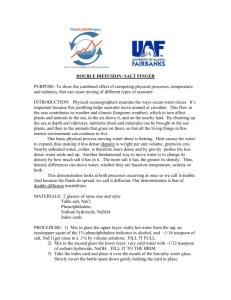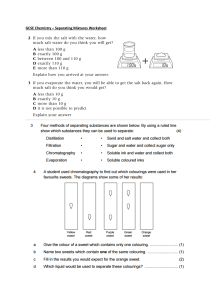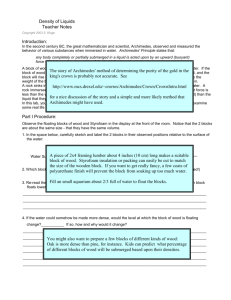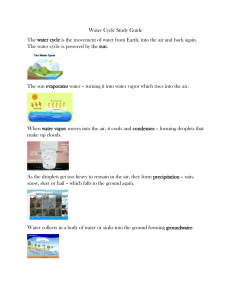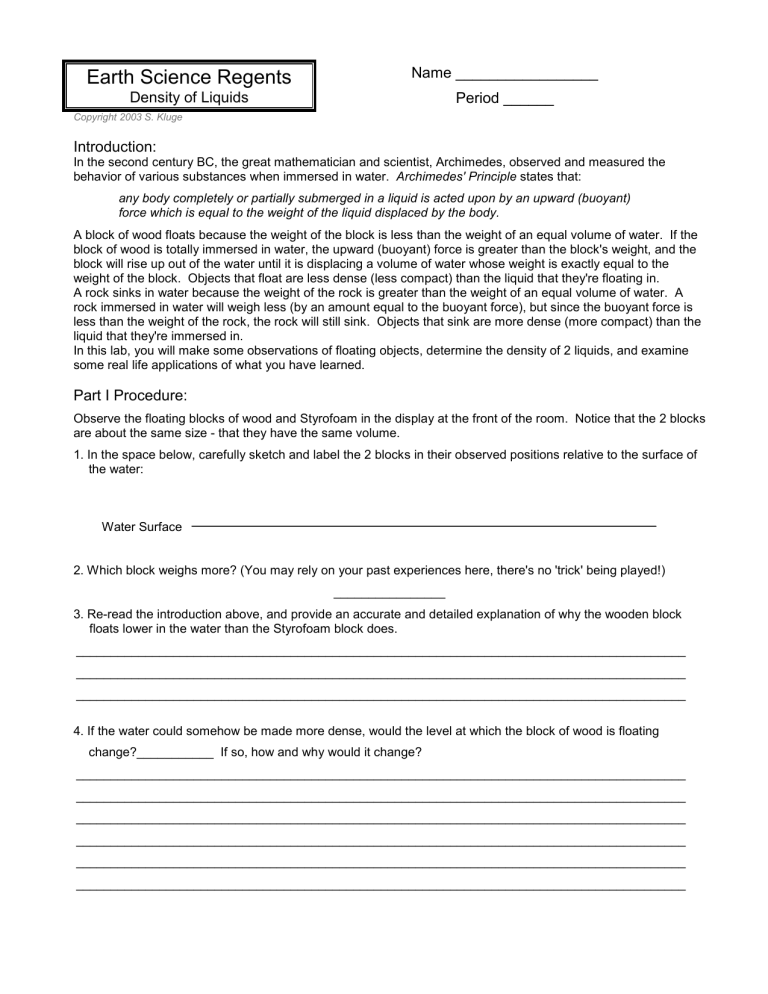
Earth Science Regents Name _________________ Density of Liquids Period ______ Copyright 2003 S. Kluge Introduction: In the second century BC, the great mathematician and scientist, Archimedes, observed and measured the behavior of various substances when immersed in water. Archimedes' Principle states that: any body completely or partially submerged in a liquid is acted upon by an upward (buoyant) force which is equal to the weight of the liquid displaced by the body. A block of wood floats because the weight of the block is less than the weight of an equal volume of water. If the block of wood is totally immersed in water, the upward (buoyant) force is greater than the block's weight, and the block will rise up out of the water until it is displacing a volume of water whose weight is exactly equal to the weight of the block. Objects that float are less dense (less compact) than the liquid that they're floating in. A rock sinks in water because the weight of the rock is greater than the weight of an equal volume of water. A rock immersed in water will weigh less (by an amount equal to the buoyant force), but since the buoyant force is less than the weight of the rock, the rock will still sink. Objects that sink are more dense (more compact) than the liquid that they're immersed in. In this lab, you will make some observations of floating objects, determine the density of 2 liquids, and examine some real life applications of what you have learned. Part I Procedure: Observe the floating blocks of wood and Styrofoam in the display at the front of the room. Notice that the 2 blocks are about the same size - that they have the same volume. 1. In the space below, carefully sketch and label the 2 blocks in their observed positions relative to the surface of the water: Water Surface 2. Which block weighs more? (You may rely on your past experiences here, there's no 'trick' being played!) ________________ 3. Re-read the introduction above, and provide an accurate and detailed explanation of why the wooden block floats lower in the water than the Styrofoam block does. ________________________________________________________________________________________ ________________________________________________________________________________________ ________________________________________________________________________________________ 4. If the water could somehow be made more dense, would the level at which the block of wood is floating change?___________ If so, how and why would it change? ________________________________________________________________________________________ ________________________________________________________________________________________ ________________________________________________________________________________________ ________________________________________________________________________________________ ________________________________________________________________________________________ ________________________________________________________________________________________ Part 2 Materials: ! ! ! ! 3 identical glass graduated cylinders balance (digital or triple beam) Salt water Fresh water Part 2 Procedure: 1. From the supply area, pick up 3 glass graduates. Fill one about 3/4 full with fresh water, and another about 3/4 full with salt water. Leave the third graduate empty. 2. Notice the eggs that have been placed in the fresh and salt water containers, and sketch your observations on the cartoon below: If the density of the 2 eggs is identical, what must be true about the density of the salt water when compared to the density of the fresh water? How do the eggs let you know that? _________________________________________________ _________________________________________________ _________________________________________________ _________________________________________________ 3. Measure the mass of the empty glass graduate and record the result in the table below. Make sure your answer includes units. 4. Measure the total mass of the fresh water and the graduated cylinder it is in, and record the result on the table below. Again, make sure you include units. 5. Measure the total mass of the salt water and the graduated cylinder it is in, and record the result on the table. Include units. 6. For both fresh and salt water samples, subtract the mass of the empty graduate from the mass of the graduate and liquid to determine the mass of the liquid alone. Record the result on the table. 7. Very carefully and accurately read and record the volume of the water in each cylinder. Make sure you read to the bottom of the meniscus, and estimate the volume to the nearest 1/10 of a ml. (Note: 1 ml is by definition 3 3 equal to 1 cm . report your results in cm on the table) 8. The density of a material can be obtained by the formula: Mass Density = Volume Mass of liquid and graduate Calculate the density of the fresh and salt water, and record the result (complete with units) on the table. Mass empty graduate Mass of liquid Volume of liquid Fresh Water Salt Water Answer the questions on the following page. Density of liquid Density of Liquids Name _________________ Questions Period ______ 1. Refer back to the observations, conclusions, and explanations you made step 2 of the Part 2 Procedures. Explain how the densities you calculated in step 8 of the procedures supports or refutes (disagrees with) the observations and conclusions you made in step2. ________________________________________________________________________________________ ________________________________________________________________________________________ ________________________________________________________________________________________ 2. The Great Salt Lake in Utah is up to 6 times as salty as the oceans. In terms of your buoyancy, what do you suppose it is like to swim in the Great Salt Lake? ________________________________________________________________________________________ ________________________________________________________________________________________ 3. The air over the eastern Mediterranean Sea is both warm and dry. As a result, there is great deal of evaporation from the surface of the sea in that area. A. As evaporation occurs at the surface of a salty sea, what kind of molecules (what substances) are leaving the sea?______________ B. As evaporation occurs at the surface of a salty sea, what kind of molecules (what substances) are left behind in the sea?______________ 4. If water molecules are leaving the sea, and salt molecules are left behind, does the sea get saltier or less salty? (circle your choice!). 5. If the water at the surface of the eastern Mediterranean gets saltier as a result of evaporation, what happens to the density of that surface water? ________________________________________________________________________________________ 6. What must happen to that salty, dense surface water? (where does it go?). CHALLENGE ! ________________________________________________________________________________________ When the salty, dense surface water of the eastern Mediterranean sinks to the bottom, it is replaced by less salty surface water flowing in from the west. Ancient sailors knew that the Mediterranean Sea had very strong currents flowing into it from the Black Sea and the Atlantic Ocean but were puzzled by the fact that the water level never seemed to rise even though there was no apparent exit for this excess water. Notice line A - B on the map of the Mediterranean Sea to the right. The profile of the sea surface and sea floor from A to B is drawn below: Use a series of short arrows - one color for less salty water, and another color for more salty water - to indicate the possible flow of water between the Mediterranean Sea and the Atlantic Ocean.

